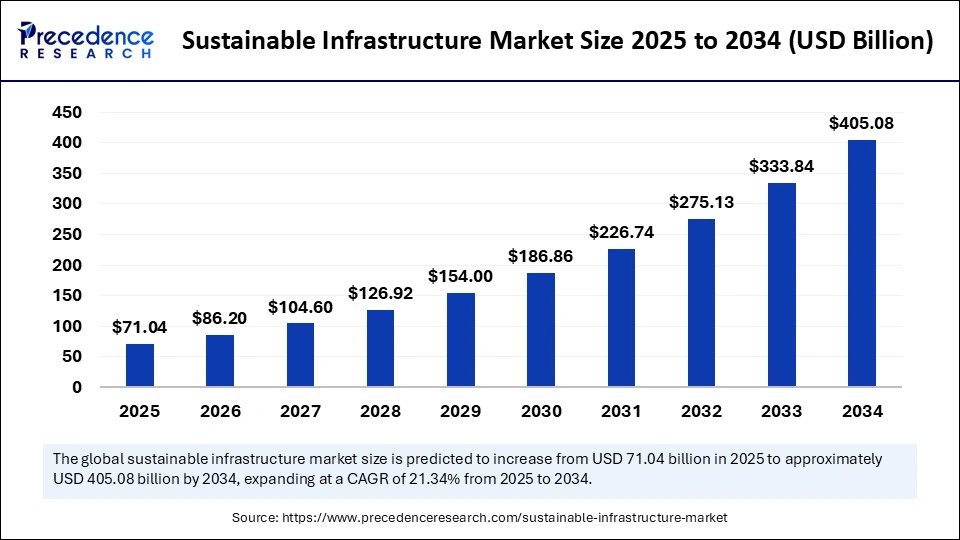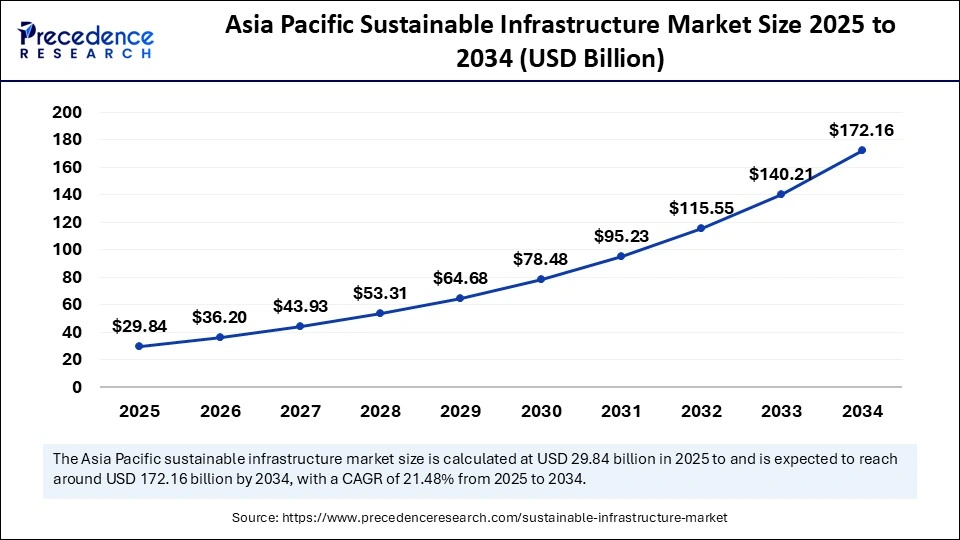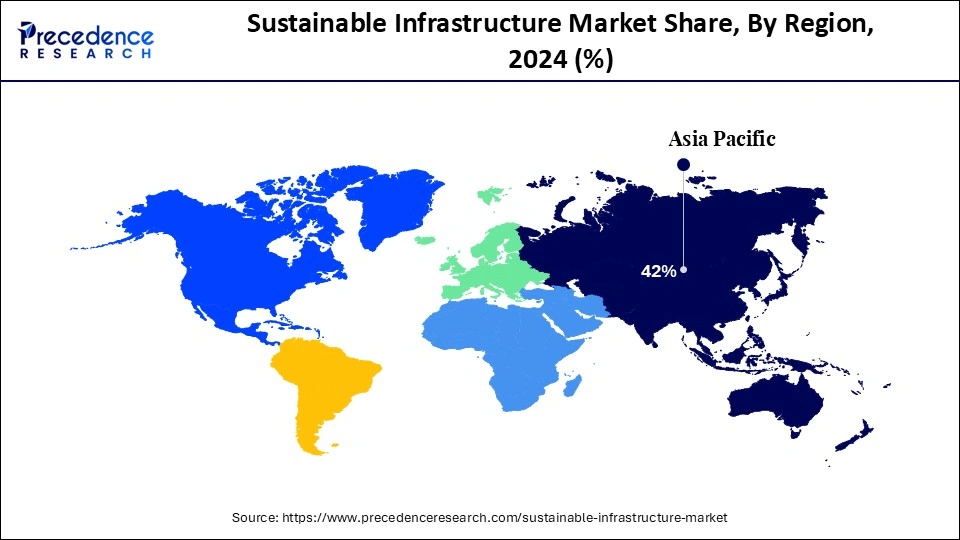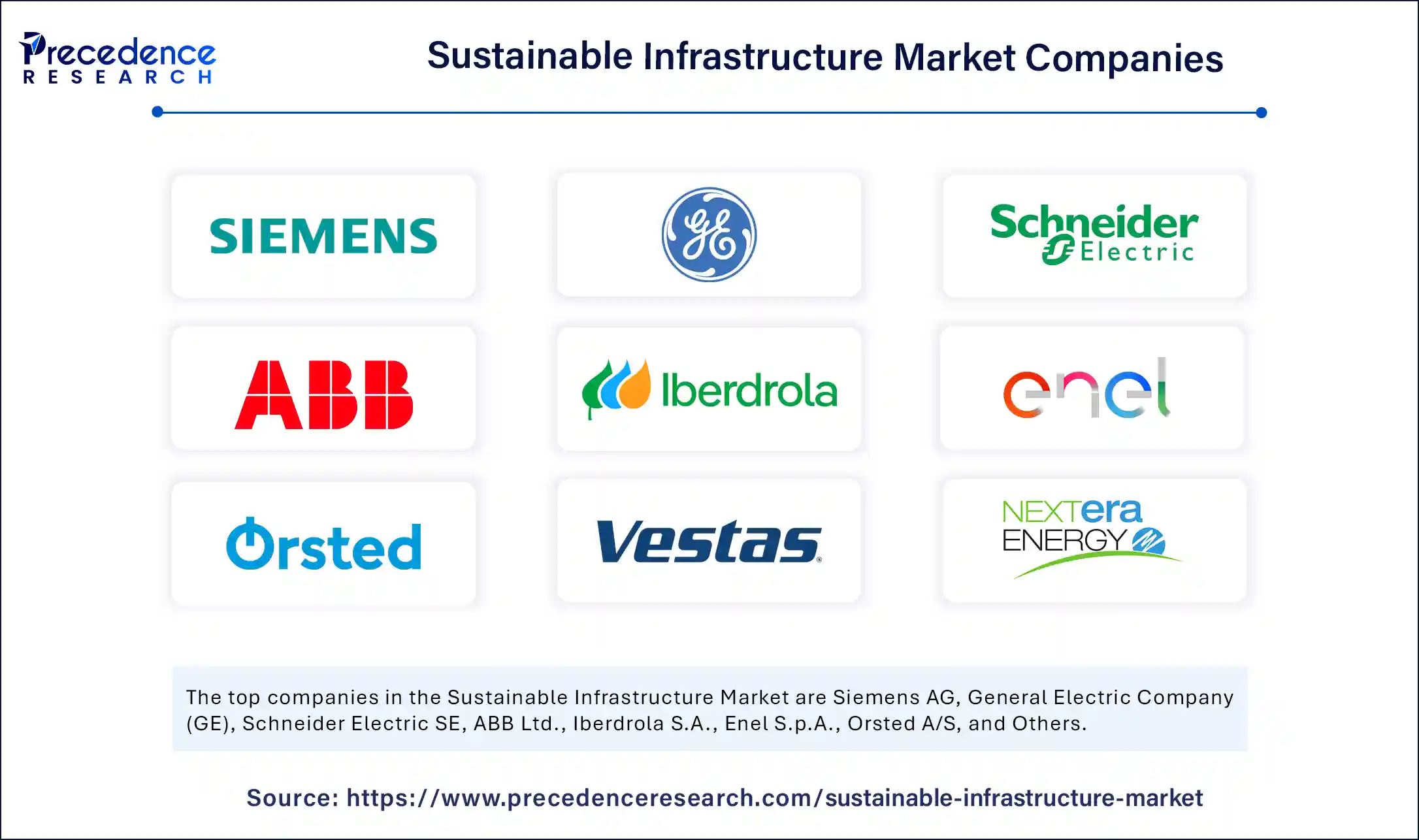List of Contents
Sustainable Infrastructure Market Size and Forecast 2025 to 2034
The global sustainable infrastructure market size was calculated at USD 58.55 billion in 2024 and is predicted to increase from USD 71.04 billion in 2025 to approximately USD 405.08 billion by 2034, expanding at a CAGR of 21.34% from 2025 to 2034. The increasing awareness about environmental decline due to carbon emissions by the construction industry and the government's pressure to adopt carbon-neutral methods to develop smart cities with a clean environment are major driving factors of the market.

Sustainable Infrastructure Market Key Takeaways
- In terms of revenue, the global sustainable infrastructure market was valued at USD 58.55 billion in 2024.
- It is projected to reach USD 405.08 billion by 2034.
- The market is expected to grow at a CAGR of 21.34% from 2025 to 2034.
- Asia Pacific dominated the largest sustainable infrastructure market with the largest market share of 42% in 2024.
- Europe is expected to witness the fastest CAGR during the foreseeable period from 2025-2034.
- By type of infrastructure, the renewable infrastructure held the biggest market share of 35% in 2024.
- By type of infrastructure, the smart cities segment is expected to witness the fastest CAGR during the foreseeable period.
- By component, the construction material segment captured the highest market share of 40% in 2024.
- By component, the monitoring and control system segment is expected to witness the fastest CAGR during the foreseeable period.
- By investment model, the public sector project segment contributed the maximum market share of 45% in 2024.
- By investment model, the public-private partnerships segment is expected to witness the fastest CAGR during the foreseeable period.
- By end-use sector, the energy and utilities segment generated the major market share of 38% in 2024.
- By end user, the building and construction segment is expected to witness the fastest CAGR during the foreseeable period.
Market Overview
The sustainable infrastructure market refers to the planning, construction, and maintenance of infrastructure assets that are designed to minimize environmental impact, improve social outcomes, and support long-term economic growth. It encompasses green buildings, renewable energy systems, sustainable transport networks, water and waste management systems, and climate-resilient urban infrastructure. Demand is being driven by global climate goals, stricter environmental regulations, rapid urbanization, decarbonization efforts, and large-scale public–private investments in resilient and low-carbon infrastructure. Innovations in green construction materials, digital twin technology, and smart city solutions are further boosting market expansion.
How is AI transforming the Sustainable Infrastructure Market?
The incorporation of AI with sustainable infrastructure will be revolutionary as it holds potential to positively impact the market growth by enhancing its design, construction, operation and maintenance which leads to improve efficiency, resilience and reduces environmental impacts across energy, transportation with urban planning, by leveraging the potential of predictive analytics to find out precise demand rate and optimize designs according to it for higher efficiency and increased cost-effectiveness. Also, simulations can be possible with the help of AI models to innovate sustainable material solutions.
AI models can further facilitate operations and maintenance for energy management, smart mobility, waste management, and maintenance of infrastructure. By analyzing sensor data through AI algorithms, equipment defects can be easily found and fixed before complete failure, which saves extra cost on equipment repairing. Also, AI-based systems can facilitate recycling efforts and reduce waste production that needs to be disposed of in landfills.
Asia Pacific Sustainable Infrastructure Market Size and Growth 2025 to 2034
The Asia Pacific sustainable infrastructure market size is evaluated at USD 29.84 billion in 2025 and is projected to be worth around USD 172.16 billion by 2034, growing at a CAGR of 21.48% from 2025 to 2034.

What factors facilitate the growth of the Asia Pacific sustainable infrastructure market?
Asia Pacific held the largest market share of nearly 42% in 2024. The region's growth is attributed to various factors like massive demand for various infrastructure with sustainability to comply with government regulations for climate change protection. Leading countries like India, China, and Japan are heavily investing in the development of sustainable infrastructure. The government is also increasingly adopting economic resilience and implementing policies that are in favor of these regulations to protect the environment from toxic elements and their emissions. Moreover, private investors and various financial institutions are actively offering capital for sustainable infrastructure to achieve goals like net-zero emissions.

How is Europe excelling in the sustainable infrastructure market?
Europe is expected to witness the fastest CAGR during the foreseeable period from 2025-2034. The region's growth depends on various factors, like government policies like the green deal in Europe, political will, along high investment by public and private firms for sustainable infrastructure. The European Green Deal is popular due to its comprehensive strategy to achieve carbon neutrality by 2050, as it sets a clear goal while offering a regulatory framework to do so. Also, the European Investment Bank is actively financing long-term sustainable projects and modernizing energy grids to enhance energy security.
What Are the Key Trends in the Sustainable Infrastructure Market?
- Integration with various technologies: A major trend witnessed by the sustainable infrastructure market is leveraging various cutting-edge technologies, such as IoT integration with smart cities, digital twins, and the use of AI for an efficient way to construct buildings. IoT and AI can be utilized for improving traffic management smartly to reduce carbon emissions. Digital twins are helpful to create virtual replicas of infrastructure for planning, maintenance, and disaster resilience, which helps optimize project planning and safety.
- Environmental management: Another significant trend for the market expansion is resource management with renewable energy usage. Shifting from traditional energy sources to solar, wind, and other renewable energy sources for efficient power distribution and minimizing waste, which leads to promoting resource efficiency. Also, implementing strategies like rainwater harvesting, management of stormwater, along developing smart irrigation systems.
Market Scope
| Report Coverage | Details |
| Market Size by 2034 | USD 405.08 Billion |
| Market Size in 2025 | USD 71.04 Billion |
| Market Size in 2024 | USD 58.55 Billion |
| Market Growth Rate from 2025 to 2034 | CAGR of 21.34% |
| Dominating Region | Asia Pacific |
| Fastest Growing Region | Europe |
| Base Year | 2024 |
| Forecast Period | 2025 to 2034 |
| Segments Covered | Type of Infrastructure, Component, Investment Model, End-Use Sector, and Region |
| Regions Covered | North America, Europe, Asia-Pacific, Latin America, and Middle East & Africa |
Market Dynamics
Drivers
Target to cope with climate change
A significant driving factor for the expansion of sustainable infrastructure is climate change and its adverse effects on the environment, and how to adapt to these changes to cope with various weather changes. A significant portion of global emissions is due to the increased rate of various infrastructure. Thus, it's essential to work on sustainable options to build various infrastructure. The increasing population across the globe has affected the ecosystem of infrastructure beyond rapid construction sites and promoted the use of more eco-friendly products. Moreover, the government's insistence on environment protection is fueling the implementation of sustainable infrastructure, creating a space for market growth globally.
Restraint
Limited materials with technical issues
The sustainable infrastructure market has some notable drawbacks, including limited material availability, with less technical knowledge to extract and use it effectively with a smaller amount, and some regions may not have a continuous supply of required materials, which leads to a loss of a substantial amount. Also, the construction and maintenance of sustainable infrastructure specifically require a skillset to use tools appropriately to implement and evaluate sustainable infrastructure. But the shortage of skilled professionals is hindering the market's growth further. Lack of knowledge about sustainable materials and understanding of their applications is a crucial hindering factor that needs to be resolved early.
Opportunity
Economic development in an eco-friendly way
A prominent opportunity that the sustainable infrastructure market holds is rapid economic development in the construction industry with an eco-friendly approach. Such infrastructures are highly efficient for energy usage and resources. Sustainable infrastructure can create various economic opportunities, like creating revenue from sales of renewable energy and offering different environmental services. Moreover, the construction, operation, and maintenance of sustainable projects like farms, smart grids, and the public transportation sector further create various vacancies, leading to the nation's economic development. By designing buildings for energy efficiency with less environmental impact, it further reduces operational costs and accelerates demand for new materials and various new techniques.
Type of Infrastructure Insights
Why is renewable infrastructure growing in the sustainable infrastructure market?
The renewable infrastructure segment held the largest market share of nearly 35% in 2024. Renewable infrastructure highly depends on renewable sources like solar and wind, with no greenhouse gas emissions, which directly impacts the environment as it produces nearly no carbon dioxide, which is hazardous to existence, and many countries are trying to reduce their carbon footprints by adopting carbon neutrality in the construction sector. Also, renewable infrastructure provides increased energy security by storing energy effectively, making it a preferred alternative for sustainable construction. Over the period, renewable energy is getting more cost-friendly and accessible to enterprises of every size to meet the standard regulations for carbon neutrality.
The smart cities segment is expected to witness the fastest CAGR during the foreseeable period. The segment is expanding due to increasing development of smart cities, creating congestion and pollution, which need to be reduced by implementing different techniques. Smart cities with sustainable transport optimize resource consumption in terms of energy and minimize waste with lower operational costs. Also, sustainable transport minimizes pollution by improving air quality and not emitting carbon excessively, which is toxic in nature.
Component Insights
Why is construction material highly in demand in the sustainable infrastructure market?
The construction material segment held the largest market share of nearly 40% in 2024. Construction activities are highly escalating in the emerging countries, creating a huge demand for construction material with emphasis on solutions that are eco-friendly and sustainable. A significant focus on building energy-efficient and environmentally friendly construction is contributing to the market's growth. Growing concerns over excessive emission of carbon can be minimized by implementing sustainable solutions for various infrastructure. Also, ongoing innovation in material science has presented the development of advanced and sustainable options like bio-based composites and sustainable wood.
The monitoring and control system segment is expected to witness the fastest CAGR during the foreseeable period. A major driving factor includes global demand for the integration of sustainable infrastructure with digital ecosystem, AI, and various policies that support eco-friendly construction. The increasing use of renewable energy sources like solar and wind requires highly complex electrical grids that demand sophisticated systems for monitoring and control to combat changing environmental factors.
The Investment Model Insights
How do public sector projects aid the growth of the sustainable infrastructure market?
The public sector project segment held the largest market share of nearly 45% in 2024. Infrastructure is considered a basic public good that is necessary for economic development. The government has made it mandatory to invest in such a project that will be beneficial for citizens without the need to have financial returns on it. Also, public sector rules define the national policies and regulations along with the necessary strategic planning needed for sustainable infrastructure. They further guide the implementation of these complex projects by offering sustainability standards.
The public-private partnerships segment is expected to witness the fastest CAGR during the foreseeable period. The public-private partnership attracts investments from private firms and reduces the financial strain on the government, supporting large-scale projects further. It further shares risk between the public and private sectors, making projects highly anticipated for investors and enhancing overall cost-efficiency.
End-Use Sector Insights
Why does the energy and utilities sector require sustainable infrastructure?
The energy and utilities segment held the largest market share of nearly 38% in 2024. The energy and utilities segment provides basic public goods and services, showcasing prominent economic activity regularly. Highly working energy systems are significantly impacting national security, public health, along economic stability, which makes it a fundamental element of infrastructure investment. In addition to this, factors like decarbonization, electrification, and growing demand for data centers have created several opportunities for market growth.
The building and construction segment is expected to witness the fastest CAGR during the foreseeable period. Governments across the globe are prioritizing the development of buildings and construction with sustainability to reduce carbon emissions and waste that will be hazardous to the environment. Governments are further promoting eco-friendly construction by presenting policies like green building standards, incentives, and tax exemptions with low interest rates, further expanding the segment's growth.
Value Chain Analysis
- Infrastructure Development
This stage involves some crucial factors for sustainable infrastructure development, like planning, design, financing, and construction commissioning for various projects.
Key players:Skanska, Stantec Inc., Siemens.
- Warehousing and Inventory Management
This stage deals with the equipment handling, storing, and transporting components and goods required for sustainable infrastructure projects to reduce carbon emissions.
Key players:Brambles Ltd, Element Logic, and ShipBob.
- Regulatory Compliance and Customs Clearance
This stage involves safety and assurance for all the activities related to sustainable infrastructure in terms of material use, component usage, and other crucial factors that need to comply with regulations.
Key players: Corpseed, Blue Berkhs Shipping Pvt Ltd, and Wire Consultancy.
Sustainable Infrastructure Market Companies

- Siemens AG
- General Electric Company (GE)
- Schneider Electric SE
- ABB Ltd.
- Iberdrola S.A.
- Enel S.p.A.
- Orsted A/S
- Vestas Wind Systems A/S
- NextEra Energy Inc.
- SunPower Corporation
- First Solar Inc.
- Tesla Inc.
- Johnson Controls International plc
- Brookfield Renewable Partners L.P.
- ENGIE S.A.
- Others
Recent Developments
- In September 2025, a strategic partnership between energy-tech giants is aligning energy demands with renewable goals, which is highly beneficial for sustainable infrastructure with energy transition. These collaborations are not just mitigating environmental risks they are creating new value chains that position green tech as a cornerstone of the 21st-century economy. (Source:https://www.ainvest.com)
- In June 2025, two leading players, AIIB and Keppel, made a collaboration to develop USD1.5 billion for sustainable infrastructure in the Asia Pacific. The collaboration will support infrastructure projects developed and invested in through Keppel's private funds, with a focus on green infrastructure, regional connectivity, and technology-driven solutions.(Source: https://esgnews.com)
Segments Covered in the Report
By Type of Infrastructure
- Green Buildings
- Renewable Energy Infrastructure (solar, wind, hydro, geothermal)
- Sustainable Transportation (EV charging, mass transit, rail, ports, airports)
- Water and Wastewater Management Systems
- Waste Management and Recycling Facilities
- Climate-Resilient Infrastructure (flood defenses, coastal protection)
- Smart Cities and Digital Infrastructure
- Others (telecom, rural infrastructure)
By Component
- Design and Engineering Services
- Construction Materials (green concrete, recycled steel, composites)
- Monitoring and Control Systems (IoT, digital twin, automation)
- Operations and Maintenance Services
By Investment Model
- Public Sector Projects
- Private Sector Investments
- Public-Private Partnerships (PPP)
By End-Use Sector
- Energy and Utilities
- Building and Construction
- Transportation and Logistics
- Water and Waste Management
- Industrial and Manufacturing
- Others (education, healthcare, rural development)
By Region
- North America
- Europe
- Asia-Pacific
- Latin America
- Middle East and Africa
For inquiries regarding discounts, bulk purchases, or customization requests, please contact us at sales@precedenceresearch.com
Frequently Asked Questions
Ask For Sample
No cookie-cutter, only authentic analysis – take the 1st step to become a Precedence Research client